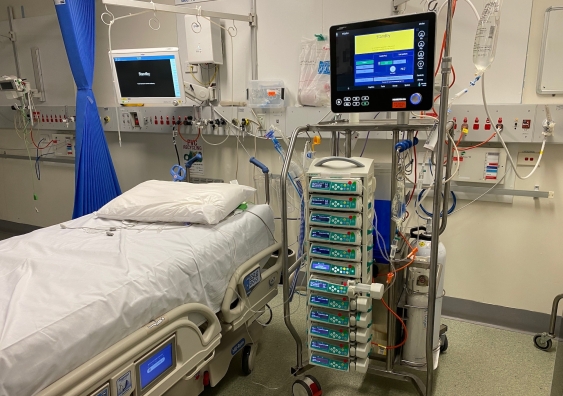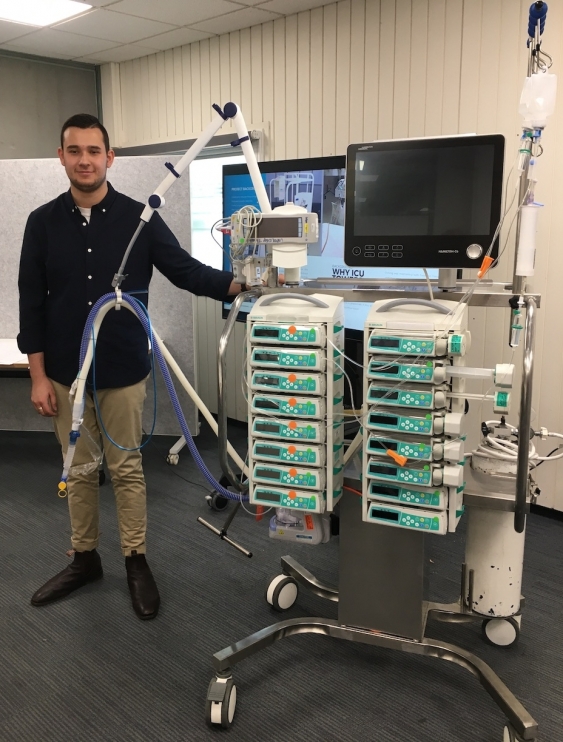UNSW students redesign Prince of Wales ICU equipment towers
A new-generation ICU unit on wheels is timely during COVID-19, when ICU capacity needs to surge.
A new-generation ICU unit on wheels is timely during COVID-19, when ICU capacity needs to surge.

Belinda Henwood
+61 (0)412 270 034
Back in 2018, Prince of Wales Hospital approached Dr Miles Park, senior lecturer in industrial design at UNSW School of Built Environment, seeking help in a redesign of their Intensive Care Unit (ICU) equipment tower. The existing model had served its purpose well for 15 years or so.
In 2021, the recently manufactured ICU towers are making a timely arrival at the hospital. Housing a new generation of equipment, including ventilators, they will prove even more useful during the COVID-19 pandemic.
According to Dr Park the tower device is “fairly unique” to Prince of Wales.
“It's a bit like an ICU unit on wheels which the staff have developed and refined in terms of its clinical use over a number of years. The patient life support and monitoring equipment travels as an entire package, together with all the IV lines, pumps, etc. still connected to the patient.”
Dr Andrew Cook, a clinical engineer at Prince of Wales and UNSW biomedical engineering alumnus, came onboard in the redesign process after delivery of the first prototype.
“We’ve got a brilliant product now that meets the clinical need and is going to serve the hospital wonderfully for the next 10 years at least,” he says.
“It's also become really useful in the time of COVID, when we’ve been preparing to surge our ICU capacity. The tower has the essential equipment an ICU patient needs, so we can just wheel it into a bed space. It allows for rapid upgrade of hospital wards to be a surge ICU, meeting the clinical need.”
For Dr Park, the redesign was an opportunity to give his industrial design students a project with practical application.
“For two honours-year courses, I used the ICU tower as a way of giving the students a project with real-world resonance. They could work alongside a client in an industry partnership before entering the industry themselves,” he says.
Dr Park’s 2019 honours-year students built on the work of those in 2018. Then in 2020, Nicholas Matkovic continued developing the ICU tower independently, using it as the capstone project for his industrial design honours year.
“The process was a lot more challenging than it usually would be. We were in the middle of a pandemic and it was difficult to get access to people,” Mr Matkovic says.
“But it’s a really lovely thing to know that I may be contributing to making the everyday working lives of those frontline ICU workers just that little bit easier. While working on the tower, I visited the hospital and I admired them so much. They were so enthusiastic and energetic, and so caring about their patients.
“All you can hope for, as a designer, is to be able to make people's lives a little better using good design principles.”
The process of redesigning the ICU tower required hospital staff and the industrial design students and staff at UNSW to work together closely, according to Dr Park.
“It wasn’t as though they could tell us what the issues were and we could go away and come up with a solution. We did some observational studies, we built some rough mock-ups and we pushed things through corridors and tried to fit them in lifts. Then the students gave a presentation to the Prince of Wales ICU clinicians.
“We really were a team with the hospital staff and it was a very supportive situation,” Dr Park says.
After the first cohort of students had finished their design, the hospital was keen to continue the work. Dr Park re-initiated the project with the next year of honours students – including Mr Matkovic – who went on to build the initial prototype.
“At the hospital, we spoke to the clinical engineering staff and the senior ICU nursing and medical staff. They showed us the existing model and how they used it, and how it wasn’t fit for purpose anymore. We got to understand how the tower is used every day and what their concerns were. Taking that information back to class, we were able to develop some ideas and concepts,” Mr Matkovic says.
At Prince of Wales, Dr Cook was heavily involved in refining the tower requirements and which devices would be housed on it.
“I worked closely with Dr Park and Mr Matkovic assisting in translating the clinical requirement and the biomedical requirements to technical design requirements. Key areas were ensuring design decisions were compatible with the medical equipment requirements and the Australian Standards,” he says.
“The clinical staff would question design decisions, ensuring the design team were considering infection control and work health and safety requirements. While meeting the equipment requirements, we also needed to ensure the tower is easy to clean and has non-porous materials, and whether there were any crevices where fluids could collect.
“When we received the second prototype, we realised we had identified and asked for a whole bunch of things that weren’t practical. Then we went through a design refinement process.”

Nicholas Matkovic presenting an ICU tower prototype at the hospital. Photo: Miles Park.
Mr Matkovic presented several iterations of the project to ICU medical and nursing staff.
“He had quite in-depth discussions about the smallest of details, and we [hospital staff] would question every design decision he made. He needed to justify it and we needed to justify any changes. It was quite a thorough process,” says Dr Cook.
“From my point of view, it was taking the clinical requirements and defining the technical requirements, and then, with Miles and the students, translating it to design requirements.”
Meanwhile, on campus Mr Matkovic was building a prototype in the Built Environment Design Futures Lab with the help of George Papadogiannis, technical officer and the lead of the lab’s metal shop.
“We took it back to the hospital for further feedback and I decided to come up with a new design based on that. It was quite a long process drawing up the new design digitally with 3D modelling software and discussing it with my tutors and lecturers on what to change and improve,” Mr Matkovic says.
Dr Park says Mr Matkovic worked beyond his commitments in his capstone project to get the project over the line in terms of final documentation and tests ready for manufacture. For Mr Matkovic, it “certainly was a team effort” with Miles and the staff at the Design Futures Lab, who he says were an amazing support through his whole degree.
“The ICU tower was a real example of how you can’t design things in a silo. We’re taught about co-design and the importance of involving the users in the process. It’s the result of their contributions,” Mr Matkovic says.
“I’m very grateful to Miles for the opportunity and for developing the relationship with Prince of Wales. I'm a really strong believer in universities collaborating with industry, because I think there's no better way to learn than to work on real-world projects.”